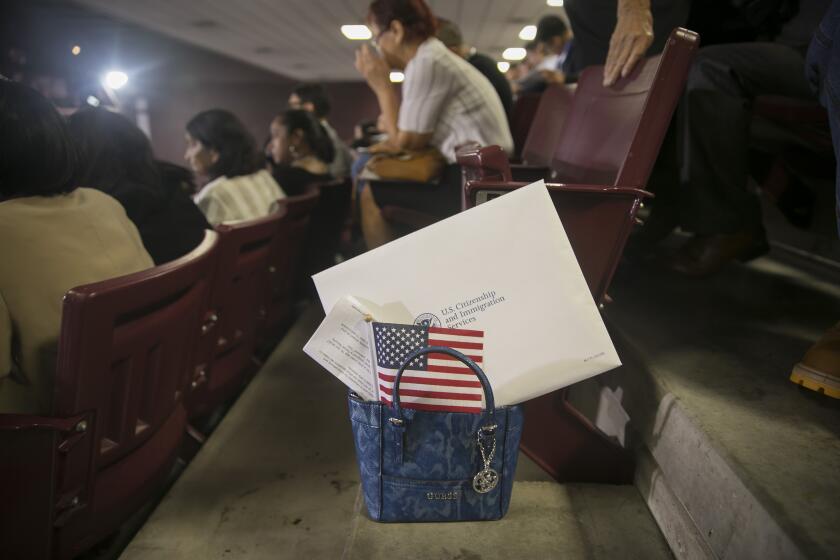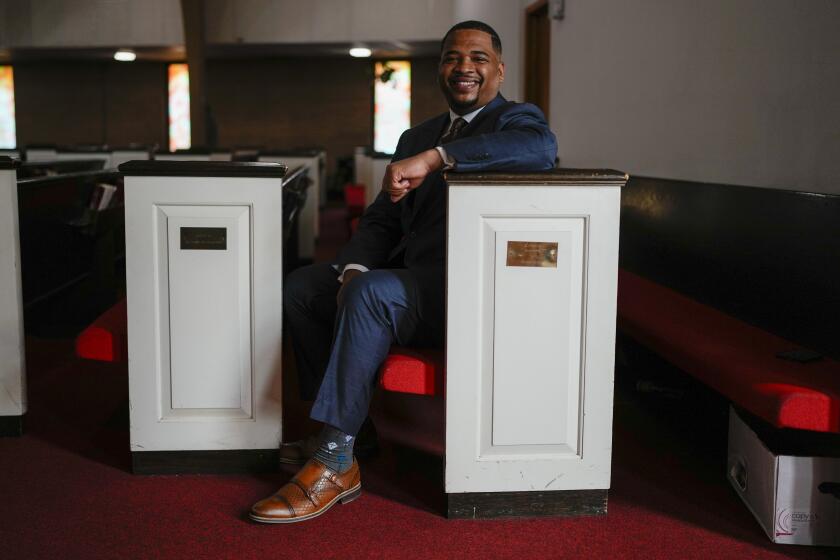Detecting radiation an arduous job at ports
The computer’s voice repeatedly droned “Gamma Alert!” until Glen Neilson, a Customs and Border Protection officer, reached up and switched it off. It was his fifth radioactivity alert in five minutes.
Neilson was working at Pier A in the Port of Long Beach, which has more such alerts than any cargo terminal in the nation. A truck hauling a rusty yellow container triggered this one.
He directed the truck to a secondary inspection station and called up the container’s shipping manifest. Something didn’t look right. The cargo was supposed to be window shutters from China.
Neilson picked up a microphone and ordered over a loud speaker “pop the can,” meaning officers would use a 4-foot bolt cutter to open the container. They brought out a hand-held isotope scanner to pinpoint the source of the radiation.
After 10 minutes, the mystery was solved. Once again, it was not a nuclear bomb being smuggled by terrorists. Instead, it was big-rig driver Francisco Villalpando of Gardena, having received a dose of medical radiation 10 days earlier, who was lighting up monitors from his driver’s seat. “I’ve been setting off radiation alarms all over the port,” he grumbled.
The system worked just the way it was designed that morning, but the incident also provided a glimpse into the difficulties customs agents have on the front line against nuclear smuggling.
Every day, about 500 radiation alarms sound at the Long Beach and Los Angeles ports, a nuisance that is growing as the federal government ratchets up the nation’s defenses.
Over the past year, customs officers have begun scanning every container that enters the United States for traces of radioactivity.
Not satisfied with that, the Bush administration has embarked on a far-reaching technological effort to achieve a nearly leakproof barrier.
U.S. radiation monitoring equipment is running at eight foreign ports that send goods to the United States and at about 450 border crossings and airports around the world.
Under federal law, 100% of cargo arriving legally at U.S. borders by 2012 will be scanned abroad and then again at U.S. ports. More sophisticated monitors, costing billions of dollars, are under development.
Ultimately, federal officials envision a time when the nation will be ringed by radiation monitors at ports, along isolated sea coasts, plying the oceans, roving highways in police cars and even dotting checkpoints on routes into major cities -- all tied into a central national command center and staffed around the clock.
Some scientists at the Department of Homeland Security are calling the effort Manhattan 2, referring to the massive project that developed the first atomic bomb.
Vice President Dick Cheney has taken a special interest in the effort and backed the political appointment of a key ally to the job of developing the architecture for the system.
But nobody is sure that any system in the foreseeable future can keep out terrorist nuclear bombs with absolute assurance. Plutonium and highly enriched uranium, contrary to public perception, have very low levels of radioactivity. With a bit of lead or other shielding material, no existing detector can find them. Moreover, lots of normal cargo -- as innocuous as granite counter tops and ceramic vases -- puts out gamma radiation.
“People think we are going to catch a terrorist bomb with these radiation monitors,” said Laura Holgate, a former Defense Department and Energy Department nuclear weapons expert now at the Nuclear Threat Initiative, a Washington advocacy group. “If we can’t catch people and drugs coming across our border, I have no confidence that we can create a seamless security perimeter for nuclear weapons.”
What’s more, pressure to deploy more advanced monitors is quickly leading to alleged abuses.
The most recent flap involves the “advanced spectroscopic portal,” a $1.2-billion effort by the Domestic Nuclear Detection Office, a part of Homeland Security. Production was stopped last month amid allegations by the Government Accountability Office that federal program managers rigged testing to certify that the equipment worked as advertised and reports that the machines were not reliable.
Rep. Bart Stupak (D-Mich.), who has held a series of hearings into the radiation monitoring program, is convinced that the new generation of monitors is no better than the old. “The next generation of equipment will only be as good as the next salesman knocking on the door of the Department of Homeland Security,” Stupak said.
While the administration is rushing to make ports invulnerable, he said, little is being done to stop potential smugglers from walking across the Mexican or Canadian borders, or to plug other obvious weaknesses in the system. “The entire strategy is wrong,” he said. “The advanced spectroscopic monitor is only one part of a much bigger problem.”
Vayl Oxford, chief of the Domestic Nuclear Detection Office, said the program hasn’t gotten a fair shake. Oxford is a veteran of national security programs. While working at the White House’s national security council, he became a protege of the vice president.
Cheney, among others, was dissatisfied with Homeland Security’s progress in developing radiation monitors. After a lengthy executive branch process, Oxford was installed in the new Domestic Nuclear Detection Office two years ago. Oxford downplayed his connections to Cheney, saying, “I know him.”
“There was a general consensus that we were not making enough progress,” Oxford said in his Washington office.
The advanced spectroscopic portal was developed with a proper sense of urgency, Oxford said. Though it is no more sensitive than existing systems, it can identify the kind of isotope that is producing radiation. As a result, it theoretically produces fewer nuisance alarms and many fewer secondary inspections.
But GAO investigators found that government contractors were told what kinds of nuclear materials would be used and where they would be placed in certification tests, allowing the vendors to fine-tune software to find the hidden packages.
When Sandia National Laboratory devised a separate, tougher series of tests for the monitors, it tricked the system simply by putting radioactive materials in places where the machines weren’t looking: inside a truck’s front bumper, for example, said William Ballard, the nuclear countermeasures chief at Sandia.
“Nothing will be perfect,” Oxford said.
The advanced spectroscopic portal is one of many systems Oxford wants to bring into action. In Seattle and San Diego, Oxford is testing radiation monitors that will be deployed at sea. In New York, he has created a coalition of 28 federal, state and local jurisdictions using radiation detection equipment, linked to a watch desk. If the system works, it will be exported to other cities starting in 2010, he said.
Oxford has put out contracts to develop a high-powered imaging system -- the Cargo Advanced Automated Radiography System -- that can see through steel containers to look for heavy metals used to shield uranium or plutonium. If deployed, the CAARS system could cost $10 billion, according to one Homeland Security official.
Meanwhile, Sandia, Lawrence Livermore and Los Alamos national laboratories, among others, have teams of scientists trying to develop a technology for foolproof container screening. Oxford’s office has issued 44 research contracts.
But outside experts say that Oxford is fighting the laws of physics, and that his spending priorities are misplaced.
The existing monitors, which use plastic crystals that detect radiation, were inexpensive and widely available when they were rushed into service after the Sept. 11 terrorist attacks.
Even though a knowledgeable smuggler can defeat them, they did improve security against a careless or unsophisticated terrorist. But developing vastly better systems will be expensive and perhaps technically difficult, if not impossible.
A senior Defense Department official familiar with radiation monitoring systems said Oxford’s goals were unattainable with any technology envisioned for decades. The official declined to be identified, because he was not authorized to critique the plans of other federal agencies.
Holgate, the nuclear weapons expert, is part of a movement calling for more effort to lock down bomb-making materials. She points to an Energy Department effort to upgrade security at Russian nuclear weapon sites and to consolidate stockpiles of highly enriched uranium at civilian reactors in former Soviet republics. “The balance is exactly backward,” she said about the big spending on radiation monitors.
No one disputes the growing threat of nuclear terrorism. As more nuclear power plants are built around the world, traffic in nuclear materials and the capability to process fuels is expected to grow. More nations want nuclear weapons, as well. All of that will expand potential opportunities for terrorists to get nuclear material and somehow sneak it into the United States.
Every year, 6,000 ocean vessels converge on Southern California from every corner of the world, carrying 5 million containers and other bulk cargo.
Todd A. Hoffman, the Customs and Border Protection seaport director, dressed in a crisp navy-blue uniform with two gold stars on his collar and a gun at his side, has much of the responsibility for preventing the entry of a nuclear device through the Los Angeles and Long Beach ports. Hoffman worries about the delicate balance between his officers not overreacting to alarms and ennui every time a radiation monitor lights up inside the guard shack -- there were 115,000 false alarms last year. A veteran of 15 years with customs, Hoffman said radiation monitors were just a tool.
“We want officers to use their experience and their sixth sense,” he said, as he watched Neilson and his other officers monitor port traffic.
The new advanced spectroscopic monitors could help make his operation more efficient, but after testing one in Long Beach the system didn’t seem quite ready for prime time.
“It is a work in progress,” Hoffman said. “This is new technology. We have issues with reliability, having the system working when we need it.
“Nothing is foolproof. The day we think the system is foolproof is the day we should quit.”
--
ralph.vartabedian@ latimes.com
More to Read
Start your day right
Sign up for Essential California for news, features and recommendations from the L.A. Times and beyond in your inbox six days a week.
You may occasionally receive promotional content from the Los Angeles Times.







